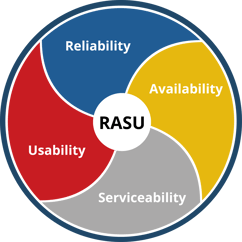So, what is model serviceability?
Model serviceability (also known as supportability) is part of IBMs RASU concept.
RASU stands for: Reliability, Availability, Serviceability, and Usability and refers to the ability of application support personnel to:
“…install, configure, and monitor an application, identify exceptions or faults, debug or isolate faults to root cause analysis, and provide maintenance in pursuit of keeping an application current and/or solving a problem and restoring the product into service. Incorporating serviceability facilitating features typically results in more efficient product maintenance and reduces operational costs and maintains business continuity.”
Serviceability Levels
Continuing with the dialogue on “clean” model design, and as part of any design or model review, an application serviceability audit should also be conducted with the objective of classifying all model support procedures that are required to maintain the model as having either a low, medium or high serviceability level.
To make the appropriate classifications, consider that the characteristics of low and medium serviceability procedures:
- Require manual intervention to initiate
- Require manual intervention during processing
- Require manual intervention to verify (complete)
- Are overly complex
- Are not repeatable without significant manual intervention
- Are “tightly coupled” to other areas or procedures within the application or other applications
- Require specific skill sets or skill levels
- Are not documented
Characteristics of high serviceability procedures include:
- Are fully automated
- Require zero or limited manual intervention
- Are encapsulated within a distinct area of the application
- Are easily repeated if required
- Are documented
Model Support Procedure Areas
Aligning somewhat to the functional areas of a “pure” model design, the model serviceability procedures can be categorized into one of the following four “types”:
- Procedures that deal with data initialization and/or manipulation
- Procedures that involve administrative maintenance
- Procedures for setting assumptions
- Procedures that are used for validation
Conclusions
Keep in mind that even an application or model that is a well designed may have low serviceability. To improve a model’s level of serviceability, you should keep the following in mind during both the model design and development phases:
- Reduce the level of administrative intervention. Most of the application service requirements should be “lights out”, automated processing.
- Automate all data processes (i.e. file creations, placement, loads and updates to TM1/Planning Analytics).
- All automated processes should include failure check points that automatically alert the system administrators of intervention needs.
- Create a sequence and dependency diagram. Most of the procedures reviewed during the audit are interconnected (Actuals loading => Actuals (cube to cube) pushes => Forecast initiation => variance reporting, etc.) and may be able to be linked into single scheduled processes. In addition, this document will clarify the general operations of the system as it relates to business processes.
- Create an administrative dashboard showing all application statuses and parameters allowing an administrator to view and adjust each through a single point of reference. This makes it easy to quickly determine the overall health of the application or where intervention may be required before it affects the availability of the application. The use of graphical status indicators is recommended.
- Modify reports to be “As Of” reports showing current states -rather than dependent upon a data push.
- Develop and maintain sufficient application user guides and run books and store them in the TM1/Planning Analytics applications folder (or similar location) for easy access.
- Develop an application performance monitoring routine.
Perhaps the best advice would be to always consider how your model will be supported and maintained before and during design and development, rather than after deployment. A model that is difficult to “service” will soon become unusable.
You can always give QueBIT a call for more information on the topic of serviceability or assistance in performing a serviceability audit of your TM1 or Planning Analytics model!